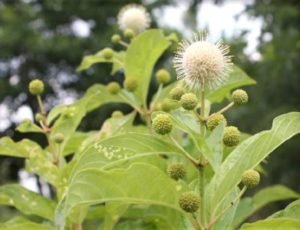

by Lydia Holley June 22, 2020
I bought a buttonbush because of its cute name. Gardeners do that sometimes. To my delight, it is blooming right now. It’s little spiky globes look as if they could be miniature solar systems, much like the tiny planet in Horton Hears a Who! I can imagine microscopic beings walking
around or lounging in the sun, thankful for the gossip gained from a butterfly’s visit.
Buttonbush (Cephalanthus occidentalis) is native to East Texas, most of the Eastern United States, parts of California, and Arizona. Bees and birds love it as much as butterflies. Mine is growing in full sun, although it will grow in shade as long as it is not deep shade. It grows in sandy and clay soils. It tolerates high pH soils.
As tolerant as it is for various growing conditions, however, it does have specific water requirements. It likes its soil to remain moist, and will even grow in standing water. Knowing this, when I planted mine, I shoveled a shallow depression so water would well around its roots. This seems to have kept it happy enough to grow and bloom.
Buttonbush grows to the size of a small tree, 12 to 15 ft tall, or you can keep it pruned to half that size. There are cultivars available that stay low and bloom with pink buttons instead of the regular white.
In the winter, its seed heads mature to a dark hue which stand out on its deciduous frame, reminding you of past imaginary planets and future fictitious worlds to emerge next spring.
For more information, call 903-675-6130, email hendersonCMGA@gmail.com.
Follow us on Facebook: https://www.facebook.com/HCmastergardener.